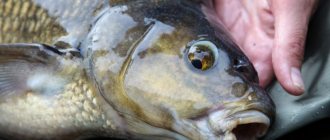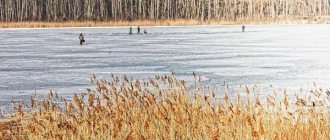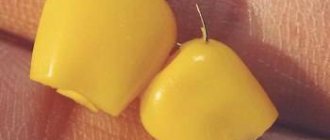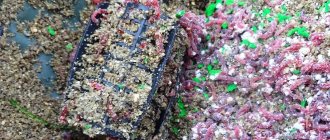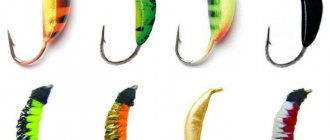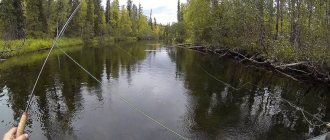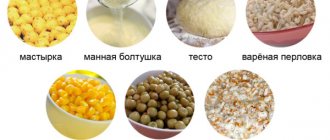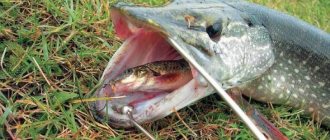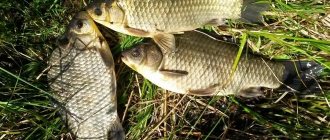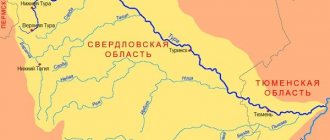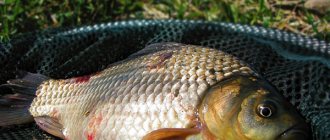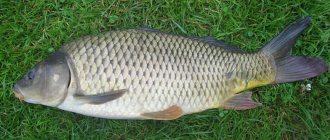- on the nature of the reservoir where crucian carp is found;
- from the presence of foreign fish, including predatory ones;
- from the presence of aquatic thickets of one nature or another.
Therefore, it is very difficult to predict the behavior of crucian carp. Crucian carp is the most common fish in our waters. Moreover, it is found in places where any other fish simply cannot survive. This fish is not demanding about the purity of the water or the oxygen content in it. Crucian carp are specially released into treatment plants as an additional indicator of water quality.
The crucian carp feeds on what it can find in a particular body of water. Its diet is very extensive and includes food of both plant and animal origin.
Vegetable baits
Crucian carp never refuses plant foods, and in some reservoirs it gives preference to them. But sometimes there are periods when crucian carp are not interested in any bait. This may be the spawning period or it may be affected by the weather. Such failures of various nozzles occur at moments of sudden changes in temperature or pressure.
Crucian carp prefers baits of plant origin, such as:
- boiled or steamed porridge from wheat, pearl barley, barley, millet, corn, peas, lupine, as well as combinations thereof;
- dough made from the same ingredients;
- hominy;
- boilies for crucian carp;
- canned peas and corn.
Where to catch large crucian carp
Representatives of the carp family are considered traditional inhabitants of freshwater reservoirs located in temperate climates. That is why an angler can easily find them in almost any lake, river, etc. However, it is not possible to catch a really large crucian carp in every place; for this, special conditions and microclimate must be formed.
In this case, such fish most often live:
- at a distance of 10–15 m from the shore;
- in bays with dense vegetation;
- near underwater holes and edges;
- near flooded trees or snags.
It turned out that everything is very simple . First of all, you need to forget about fishing in such places with a float rod. And especially with blind equipment. You can only cast it near the shore. Just where small fish live, which do not give large ones a chance to “see” the bait.
There are quite a lot of small, unexplored bodies of water in our country. As a rule, these are flooded ravines, shallow lakes, and ponds. The water in such reservoirs warms up quite strongly, which creates unfavorable conditions for the life of predatory fish.
And for crucian carp
But for crucian carp this is paradise! Some time passes, and the fish in such reservoirs “shrink”, that is, a lot of young fish appear, which mainly bite on the fishing rods of local fishermen.
It seems that there are no large crucian carp here at all. However, this is not so - it is there, but not so much. And yet, he is much more careful about gear than his younger brother.
What to do? We need to catch him somehow. The answer to this question was found by fishermen near Moscow. But before we voice it, let's look at the features of fishing and the life of fish in this reservoir.
Based on these features. Fishermen near Moscow have adapted to catching large crucian carp.
It turned out that everything is very simple . First of all, you need to forget about fishing in such places with a float rod. And especially with blind equipment. You can only cast it near the shore. Just where small fish live, which do not give large ones a chance to “see” the bait.
[THERE IS AN ANSWER] Which floats are best to use for catching crucian carp
Next, you need to give up bait , no matter how rude it may sound. Since the fine particles are collected first of all by the fines, and the large fish get nothing.
Large crucian carp is pleasing to the eye
Catching large crucian carp in wild reservoirs in most cases occurs with a small pickerel. This is quite relevant and convenient.
Equip it with a Gardner loop (about 10 cm) and hang a small weight (especially if the bottom is muddy) weighing 12-15 grams in the shape of an olive.
The loop for the leash should be 5 cm below the load itself to prevent the line from getting caught when casting. A leash with a self-cutting hook can be placed small - about 40-50 cm and attached loop to loop.
The cross-section of the main line is 0.16-0.18, and the leash is 0.12-0.14. You shouldn't use a very thin leash, because... There are quite large “surprise” bites. It is advisable to use a sinking line for the main line. This will allow you to feel more comfortable on the pond in wind and waves.
Catching large crucian carp in wild reservoirs does not require bait.
And now the most important thing to learn is the nozzle . In early spring, a dung worm will do (you can even spray it with worm flavoring). You don't need to put it on as usual. We take the nozzle and cut it into several parts (3-4). Each part is no more than 1-1.5 cm and we hook these parts onto a hook so that it looks like some kind of “tassel”. There is no need to cover the hook tip.
Catching large crucian carp in wild waters in most cases occurs from the shore. But it is possible from a boat.
Such tackle is thrown far enough from the shore (pits, edges, depth changes, etc.) and placed on the “slingshots”. The tip of the rod will show the bites of large crucian carp. They will be very sharp, sometimes downright unexpected. If the “brush” is large enough, then the little thing usually doesn’t bother you (it may bother you, but you can’t see any bites and it can’t pull off the worm).
True, bites will be quite rare and you will have to get a chair, but if they do bite, then “big time”.
In spring and autumn, bites occur at almost any time of the day with short breaks, but in summer, it is better to fish in the morning and evening.
- crawling worm;
- maggot;
- bloodworm;
- grasshopper;
- dragonfly
Animal nozzles
Depending on when you are fishing, in spring, summer or autumn, it is advisable to have bait of both animal and plant origin in your arsenal. Moreover, during such periods, animal baits are never superfluous. Crucian likes:
- dung worms;
- crawls;
- earthworms;
- earthworms;
- maggots;
- bloodworm;
- bark beetle;
- dragonfly larvae;
- mayfly;
- May beetle.
Animal baits can be used either individually or in various combinations, which makes the bait more attractive to crucian carp. These are the so-called sandwiches, when worms and maggots, bloodworms and maggots, as well as combinations of animal and plant baits are attached to the hook.
But there are periods when crucian carp refuses any bait offered to it.
Depending on the nature of the reservoir, crucian carp may give preference to either animal or plant food throughout the entire fishing season. Therefore, crucian carp is considered an unpredictable fish in terms of gastronomic preferences.
Crucian carp baits and baits
Sandwich of two bloodworms and maggots
In spring and early summer, baits of animal origin work well when catching crucian carp:
- bloodworm;
- maggot;
- muckworm.
And if maggots and bloodworms can be bought in a store, then it is better to get the worm yourself. Crucian carp has a particular weakness for red dung worms, which live in compost, rotted manure, and in the soil next to manure. It is better to look for them near livestock farms. These worms have a strong odor that attracts fish. If the crucian carp is capricious, you need to try to catch it with sandwiches, for example, 2-3 bloodworm larvae and one maggot.
In summer, crucian carp are better caught by anglers with culinary skills. Now you have to bustle around the kitchen stove to bake a delicious pancake, steam soft barley, prepare aromatic dough or mash. But here too, fishermen find various innovative ways. So the pearl barley is poured into a thermos and filled with boiling water. In four hours the bait will be ready. All you have to do is add honey or breadcrumbs, and the crucian carp will not be able to resist this “dish”.
Tips for fisherman: How to cut crucian carp for smelt fishing - Answers for beginners
The number of dough recipes is almost equal to the number of fishermen. The meaning of the nozzle is simple. Flour (wheat, corn, peas, semolina) is mixed with water and mixed thoroughly until the dough does not stick to your fingers. This is the basis of the test. You can add various ingredients and flavors to it, bringing the bait to the desired condition. The feeder is also filled with the same bait.
What to do if it doesn't bite?
7 simple tips for beginner anglers! How to set up a float rod - detailed instructions.
Crucian carp likes to be in holes, in reeds, next to vegetation and in depressions.
What to use to catch crucian carp in winter
In most cases, crucian carp are in a state of suspended animation in winter, which means they do not feed. But in some cases he is forced to feed in winter. This happens in the following cases:
- If it is found in heated, artificially created reservoirs, where temperature conditions are stable. Elevated temperature conditions allow crucian carp to lead an active lifestyle throughout the year.
- For the formation of a new reservoir or quarry, where there are no conditions for hibernation or it suffers from a lack of food, which will not allow it to store nutrients for the winter. Then he continues to look for food in conditions where the reservoir is covered with ice.
In reservoirs where the water temperature fluctuates within small limits, winter bait for crucian carp does not undergo significant changes depending on the season, in contrast to ordinary reservoirs, where bait alternates from spring to autumn. In such reservoirs, spring fishing for crucian carp prefers animal baits, summer fishing prefers more plant baits, and in the fall again animals. In warm waters, the same baits are used as for summer crucian fishing.
In ordinary reservoirs, when they freeze for the winter, cold water provokes crucian carp towards animal baits, since it needs more energy. When it is not yet very cold, crucian carp will happily bite on bloodworms, burdock moth larvae, dung worms and maggots. Towards the middle of winter, when the oxygen level in the water drops noticeably, the crucian carp falls into a stupor, not responding to any bait.
Large specimens of crucian carp are well taken on a large dung worm or on protein dough.
When the ice begins to gradually leave the reservoirs, the crucian carp comes to life and begins to actively feed. The best baits at this time are bloodworms and maggots or a combination of these baits. At the same time, crucian carp will not refuse a dung worm as the most universal bait.
Most popular gear
If we talk about catching small specimens , then you don’t have to worry too much about the equipment and the selection of bait: in the summer in the morning, small crucian carp literally rushes at everything offered, especially if you choose the right place and feed it correctly.
Tips for fisherman: How to catch asp with a spinning rod in the summer - Let's take it step by step
Large specimens are much more careful - they do not even swallow bait right away, so it is recommended to use fairly delicate equipment when catching trophy crucian carp. In this case, special attention is paid to choosing a promising location and preparing gear. In this case (especially when using a feeder) we are dealing with a process similar to carp fishing, albeit in a simplified version.
Float rod
Fishing from a boat brings very good results, especially in large water bodies. In this case, islands of vegetation distant from the shore deserve special attention: they are clearly visible from a boat. In this case, there is no point in fiddling with a long rod, because you can swim close to the thickets. The main thing is not to tangle the equipment when fishing.
The use of matches in this case is appropriate only if the fisherman knows the bottom topography of the reservoir. It makes sense to cast to places of bottom anomalies, paying special attention to holes.
Feeder gear
It is worth catching crucian carp on a feeder if you have any experience in this field. By the way, this will be good training for the future carp fisher. In this case, as in the match option, a preliminary study of the bottom topography for anomalies is mandatory.
The best option would be a form up to 4 m long, with a soft quivertype and dough up to 100 grams. The requirements for the reel are not so stringent: special strength, capacity and the presence of a baitrunner are not required, since crucian carp usually do not grow too large.
Donka
Classic bottom equipment for catching crucian carp does not need any special adjustments: everything is as usual, without any special nuances. In a budget option, you can use monofilament with a diameter of 0.2 mm as the main fishing line. Loops should be made on it for attaching leashes in increments of about a meter, and a sinker should be attached to the end. The length of the leash should not exceed half a meter, and the hooks must be equipped with foam balls, otherwise the nozzle will simply drown in the silt.
Do not forget that when casting a donkey, you should choose places free from vegetation. It is better to place a classic donk at night and rely on self-hooking, because each bite means removing the gear and then casting it with a fairly noisy splash that can scare away the fish from the fishing spot.
An intermediate option between a feeder and a classic donkey is a tackle option with a rod equipped with an inertia-free reel (cheaper “inertia” reels can be used, but this complicates the process of casting and landing fish, especially large ones). In this case, you can use a budget fishing rod of any class and regular monofilament, because crucian carp weighing over a kilogram is already a rarity.
There is enough natural food for crucian carp in summer. Therefore, bait should be minimalistic. For fishing among the thickets, they are fed with several handfuls of crumbly food just to maintain the fish’s appetite. If the reservoir is poor in its own food resources, then the volume of bait increases to a kilogram or two, but no more.
Summer crucian fishing usually includes the period from the second half of May to the end of September. But for the northern regions this period is compressed. Throughout the summer, crucian carp fishing is carried out using the same methods, without any changes characteristic of spring and autumn, when significant temperature changes occur. How to adapt to the habits of crucian carp in the summer, how to catch it on the warmest days, we will consider further.
How crucian carp behave in summer
Small crucian carp (slow-growing forms) densely populate the coastal area in summer and are excellently caught. But large crucian carp behaves completely differently - it moves along paths, is picky about bait, is difficult to catch, and is affected by a large amount of natural food.
Fishing rod for summer fishing
In summer, crucian carp are mainly caught with a fly-float rod. Light tackle with sensitive equipment is used. The line ranges from 0.08 to 0.12 mm, only in conditions of catching large specimens among algae it can be 0.16 mm. Floats are generally 0.5 - 1.0 grams, for long rods and windy weather - up to 2.5 grams to keep the rod under control in difficult conditions.
Techniques for catching crucian carp with a fishing rod in summer
But when there is no wind in the windows of aquatic vegetation, for catching crucian carp in the summer, it is effective to use equipment without any weight. The bait slowly sinks under its own weight or as a result of pulling on the line. The bite is determined by the fishing line or float moving to the side.
Often, in summer, crucian carp prefers to take the bait not from the bottom (which is the classic way of supplying a bait for crucian carp), but suspended at the bottom or even in the water floor. In any case, when the bite from the bottom stops, it is recommended to check whether the crucian carp has changed its horizon.
Also, when fishing over very muddy mud, hanging the bait remains the main technique. But, as a rule, even crucian carp avoids very swampy places, since wind currents make the water there too cloudy.
Crucian carp on donks in summer
For summer fishing for crucian carp, feeders are widely used together with foam balls as bait on hooks. Here the crucian carp hooks itself, so this type of fishing is not sportive; many similar baits are used at the same time.
The tackle itself for catching crucian carp using polystyrene foam looks like this. Feeder in the form of a twisted spring designed for 100 - 150 g. feed, which is attached with a swivel to the fishing line. At the edges of the spring, two leashes made of thread (braid) with a length of about 5 cm are tied. No matter how the feeder lies on the bottom, the hooks with foam bait will always be above the food.
Tips for a fisherman: How to put a maggot on a hook for crucian carp - Answers for beginners
The hooks are chosen to be light, and the food is made muddy and dusty, then the foam is accepted by crucian carp a little better. There are many modifications of this kind of donkey for crucian carp, when foam balls are combined with pieces of cake, or sinker feeders of various shapes are used, special feeds….
Summer crucian carp and feeder
Basic baits for catching crucian carp in summer
Classic animal baits - bloodworms, worms, and maggots - remain in demand for catching crucian carp always in the summer as well. But summer fishing has the peculiarity that crucian carp can be caught without bloodworms, using only plant baits.
Most often, semolina, rolled oats, pearl barley, pea porridge and wheat dough are used to catch crucian carp in the summer.
A common but effective bait for catching crucian carp in summer is a semolina chatterbox. This is a dough made from semolina “in a hurry” in a pond. The preparation of the mash is as follows. A little semolina is poured into a jar, into which water from the reservoir is gradually added while constantly stirring with a stick. 15-20 minutes of stirring - and the mash is ready. You should get a viscous homogeneous mass. It is more convenient to bait the chatterbox using a medical syringe, from which the dough is squeezed out and at the same time wrapped around the hook.
Feed crucian carp in summer
There is enough natural food for crucian carp in summer. Therefore, bait should be minimalistic. For fishing among the thickets, they are fed with several handfuls of crumbly food just to maintain the fish’s appetite. If the reservoir is poor in its own food resources, then the volume of bait increases to a kilogram or two, but no more.
Fishing for crucian carp in summer is a very popular holiday. In order for catches to differ from the average, you need constant practice, a persistent search for fish locations, and selection of the optimal bait. This is why fishing for crucian carp in summer is interesting.
- standard hooks are replaced with larger ones, 9 mm in size;
- On each hook only a large ball, a massive fragment of a worm, etc. is put on;
- Be sure to use the so-called “hair” attachment.
Spring baits for crucian carp
With the arrival of spring, all nature begins to gradually come to life, including crucian carp. It begins to approach the shores, where the depth is shallower and the water is warmer. With the beginning of spring, aquatic vegetation begins to awaken. First of all, it comes to life in the shallows, where crucian carp find it as food.
During this period, crucian carp can be found at depths of up to 1 meter, and the main gear for catching it is a regular float rod. Since the ice melts faster on rivers, the crucian carp comes to life earlier than on ponds and lakes where there is no current. At this time, crucian carp actively bites on:
- bloodworm;
- a combination of bloodworms and maggots;
- red worm;
- dough or mastyrka.
Under certain conditions, already in March, crucian carp can be caught using semolina or mackerel, as well as steamed millet or pearl barley. But this depends on the nature of the reservoir, as well as weather conditions.
On ponds where there is no current, crucian carp emerge from hibernation quite slowly. At the same time, it gathers in flocks and migrates through the reservoir closer to the surface, where the water is somewhat warmer. In such conditions, crucian carp take on floating baits.
With the arrival of April, crucian carp are also caught closer to the surface. The bait can be caterpillars, worms, bloodworms, etc. At the same time, he does not take the bait right away, but studies it for a long time. If you “revive” the bait by making a stepwise retrieve, then there is a high probability that the crucian carp will decide to bite. By mid-April, crucian carp begins to sink closer to the bottom and can be caught from the bottom or from mid-water. During this period, crucian carp begins to be caught with any bait, as it begins to prepare for spawning.
Smaller crucian carp switches to feeding on caddis flies, but larger ones do not overeat and bite on white or dung worms, caterpillars, crawlers, leeches, etc.
After spawning, it is very difficult to determine the gastronomic preferences of crucian carp, since it is still sick. When going fishing, it is better to stock up on both animal and plant bait. In the spring, you have to change bait and very often in order to please the crucian carp, otherwise you may be left without a catch.
Starting from mid-May, crucian carp go to spawn. During the spawning period you can hardly count on a serious catch. During this period, you can only catch crucian carp that does not participate in mating games.
First of all, river fish spawn, followed by crucian carp, which inhabits shallow reservoirs, and finally, crucian carp, located in deep reservoirs, where the water warms up very slowly. With the beginning of spawning comes calendar summer, and with it bait of plant origin. But this does not mean that in the summer crucian carp will not bite on bait of animal origin, especially a worm.
Types of summer baits
In principle, crucian carp is omnivorous, that is, it does not disdain either plant food or food of animal origin. But obvious preferences depend on many factors, in particular on the characteristics of the reservoir in which it lives. If a river or pond is saturated with vegetation, fish can greedily attack animal, i.e., protein food. Summer is the time for experimentation. You can successfully fish with a “sandwich”, that is, two types of bait placed together.
Animals
Some types of insects and worms can be purchased at a specialty store. Others you can get or grow yourself.
Best animal material in summer:
Vegetable
This type of bait is prepared independently and does not require any special culinary skills.
So, catchable plant bait:
Artificial
The advantage of artificial bait is long-term storage, and also that the material does not deteriorate in water.
For crucian carp fishing, three types of bait are used:
It is preferable to collect worms before sunset, since after the sun hides behind the horizon, the worm is drilled as deep as possible into the ground or pus. But this is what concerns baits of animal origin. But if we are talking about plant baits, then it is noteworthy to note that the best bait for catching crucian carp is a bait based on durum varieties of barley, wheat, etc.
Crucian carp is an omnivorous fish, which is why bait of animal and plant origin is used to catch it. The most appetizing ones for crucian carp are: bloodworms, maggots, worms (both dung and earthworms are suitable). Water insects also serve as excellent bait. It is believed that the most intense hunger for crucian carp occurs in the spring. Experienced fishermen know that crucian carp belongs to the family of capricious fish, which can be traced at least in its pickiness to food.
Of all the different baits, crucian carp probably like maggots and bloodworms the most. With this type of bait, crucian carp are successfully caught throughout the summer. The most optimal conditions for storing maggots are in containers that have good heat transfer. Absolutely any box is suitable for this, provided that it is wrapped in a damp cloth. Since the jar will be cooled, maggots will not pupate as quickly.
Tips for fisherman: How to make feeder gear for crucian carp - What to choose for fishing
It is preferable to collect worms before sunset, since after the sun hides behind the horizon, the worm is drilled as deep as possible into the ground or pus. But this is what concerns baits of animal origin. But if we are talking about plant baits, then it is noteworthy to note that the best bait for catching crucian carp is a bait based on durum varieties of barley, wheat, etc.
Also, crucian carp are called “sweet lovers”, as the smell of honey gingerbread attracts them with unrealistic force. It is worth noting that crucian carp fishing can also be done using a housefly. This type of bait is suitable for catching small crucian carp, which are mostly found in shallow reservoirs and rivers. Since such areas serve as a watering hole for livestock, fishermen are accordingly accustomed to the presence of flies, so such bait is not alarming to them, and therefore crucian carp easily bites on this bait.
Let's look at the four main types of spool geometry for a spinning reel - deep (Classic), shallow (Air Spool), long-tapered with a regular cone (Long Cast), with a reverse cone (ABS).
Summer bait for catching crucian carp
In summer, crucian carp are not as active as in spring. When going fishing, it is difficult to predict what the crucian carp will start to bite on, since it becomes capricious and picky about bait. During this period, he has enough food that is in the reservoir, so the crucian carp needs to be surprised with something. In summer, crucian carp is very dependent on weather conditions and its bite becomes unpredictable. This is especially felt in unfamiliar reservoirs, where crucian carp have their own diet and life schedule.
Despite the fact that in summer the fish mainly switches to plant nutrition, crucian carp all summer can only peck on a dung worm or a worm dug up near a reservoir. This factor is influenced by the characteristics of individual reservoirs. At the same time, he can easily refuse the purchased one. This means that the crucian carp in this reservoir eats only the food that it knows well.
In reservoirs that are fed by cold rivers or underwater springs, crucian carp also prefer animal baits. Being in cool water it needs more nutrients. In this case, any insect larvae, bloodworms, maggots, caddis flies and their combinations are suitable.
In reservoirs where the water quickly warms up and becomes warm, crucian carp really prefer baits of plant origin, such as:
- boiled pearl barley;
- steamed wheat;
- boiled or canned peas;
- steamed or canned corn;
- semolina;
- boiled lupine;
- dough of various origins.
Small crucian carp actively bite on the crumb of white bread or mastyrka made from white flour.
During this period, crucian carp may be interested in an animal-vegetable sandwich, for example, a barley worm. The same is true for other types of bait, such as crucian carp boilies.
With the arrival of real heat, crucian carp eat very little and come out of their hiding places in search of food either early in the morning or late in the evening, when there is no heat. During these periods, crucian carp may abandon traditional baits of animal origin in favor of plant baits. With extreme temperatures, crucian carp can go to depth and hide for some time. Closer to autumn, crucian carp again begins to actively search for food in order to stock up on nutrients for the winter.
Features of catching large crucian carp
When catching heavy specimens, you need to choose the right place for fishing. You need to select tackle, bait and groundbait.
How to choose a fishing spot
The most suitable reservoirs for catching trophy crucian carp are:
- Medium-sized flowing and stagnant lakes;
- Bays and oxbows of rivers;
- Large reservoirs;
- Cascades of small marshy lakes;
- Peat digs;
- Stakes and large ponds.
On a note! Large specimens of crucian carp are practically never found in reservoirs with a weak food supply, a hard sandy or clay bottom, and a large number of predators - perch, pike.
Tackle and bait
Weighty specimens bite on baits of both animal and plant origin.
For bait, large fish prefer dung worms, a bunch of bloodworms, white maggots, and shitik. In bodies of water near which there are meadows, it even catches a grasshopper quite well.
Among the variety of plant baits, large specimens are more willing to bite on:
- Dough made from wheat or corn flour;
- Pea porridge “Mastyrka”;
- Barley;
- Undercooked potatoes"
- Corn.
Somewhat less often, large fish take semolina and crumbs of white or black bread.
It is best to catch large crucian carp using the following gear:
Tackle with long rods is used on large bodies of water. Short and less long-range - on medium-sized bays, lakes and ponds.
Lure
When catching weighty specimens, both purchased specialized crucian carp baits, for example, from RS, Traper, Sensas, Vabik, Dunaev, and homemade mixtures are used as bait.
Homemade groundbait is prepared by mixing breadcrumbs, cake, boiled barley, steamed peas, and millet in equal quantities. In spring and autumn, cut worms and crushed bloodworms are added to the bait mixture. Maggots are not added to the bait, since the motile larvae accumulate at the bottom of the container in which the mixture is prepared and very rarely end up in the feeding balls. Clay and soil from molehills are used as ballast for bait used when fishing with float gear.
Crushed garlic, ginger, honey, and heart drops (Corvalol, Valocordin, Valerian) are used as flavorings added to plant baits and bait.
If you still cannot get rid of small fish biting, you can solve the problem by changing the casting range of the bait . In this case, you should definitely use the following rule: large fish live only at maximum depth and distance from the shore. However, when fishing with float gear, this will not be possible, so in this case it is recommended to change the fishing location.
What do you use to catch crucian carp in the fall?
Even in September, it is difficult to notice that crucian carp begins to hunt for various bugs and worms. In September, he still doesn’t mind trying a delicious plant-based dish. But here everything depends on the weather, if the weather is warm in September, then the crucian carp may not notice that it is already autumn on the calendar and, by inertia, takes everything that is offered to it.
With the arrival of October, the behavior of crucian carp changes dramatically, especially if it gets cold outside and the water temperature begins to drop rapidly. Crucian carp begins to actively eat underwater insects and their larvae. During this period, he will not refuse either a regular or a dung worm. Still, the best baits may be the larvae of various insects.
The colder it gets, the less active the crucian carp becomes and the harder it becomes to interest it with various baits. During this period, he can peck exclusively on animal baits, such as a worm (in pieces) or bloodworms. Therefore, you should not count on a good bite of crucian carp at this time.
Crucian carp is a cautious and capricious fish that bites today, but tomorrow it will no longer take any bait. Or it could be this: yesterday the crucian carp pecked intensely, but today it’s very sluggish, and no matter what you offer it, it refuses. Naturally, the behavior of crucian carp, like other fish, is influenced by weather conditions, but in what way it is still not clear.
Therefore, when going for crucian carp, you need to have at least some information about its behavior. As a rule, such information spreads among fishermen at high speed. Finding out on which body of water crucian carp is caught if you know fishermen is not at all difficult. But this does not mean at all that the crucian carp will bite tomorrow, so you should always be prepared for this situation and take several types of bait with you just in case.
Choosing gear for catching crucian carp and features of use
Today there are really many variations of gear for catching crucian carp. But the most common, popular among fishermen, are the following:
- Float rod.
- Feeder.
- Donka.
- Rubber.
- Spring.
Tips for a fisherman: How to put a maggot on a hook for crucian carp - Answers for beginners
Let's take a closer look at them.
Float rod
This fishing rod is a combination of a rod, line with float, sinker and hook. For many anglers, this is the best option for catching crucian carp. You can fish this way both from a boat and from the shore.
The main requirement for a float rod, as for any crucian tackle, is high sensitivity, because crucian carp bites quite carefully, so you need to be able to hook it in time. The rod should be stiff so that you can hook the fish and prevent it from leaving. The float is light.
Feeder
Also a fairly common tackle. The whole essence of fishing comes down to the fact that with the help of a reel and a strong rod, the length of which varies quite greatly, a feeder with bait is cast. This attracts crucian carp, which, along with the food, grabs the baited hook.
When choosing, there are several points to consider:
- The rod should be of medium weight; options that are too long will not work.
- Feeders are suitable weighing from 50 to 80 grams, depending on whether you are fishing in currents or in standing water.
The feeder is used for casting over long distances and to depth. The feeder performs excellently on lakes and when fishing for large fish.
Donka
This fishing rod itself represents a fishing line with a load. Hooks are located on leashes above the load. The essence of fishing is as follows: the load is untwisted and thrown to the right place. In order to detect a bite, a bell alarm is used.
The optimal time for fishing with this method is cold, cloudy weather. At this time, the fish just goes to depth.
Rubber
This tackle has much in common with a regular donka. True, there is one additional element - an elastic band, which gave it its name. The elastic stretches when the fishing line attached to it is pulled out, and then returns back. This type of gear is used in various bodies of water. Multiple hooks allow you to try different baits.
Spring
This is a bottom tackle that has a spring-shaped feeder. Leashes are tied to the spring itself. The spring itself is first filled with bait. And the hooks are slightly recessed into it. When the fish eats the bait, it will grab the hooks.
This is a fairly catchy tackle; it can catch quite large fish.
For crucian carp fishing, three types of bait are used:
